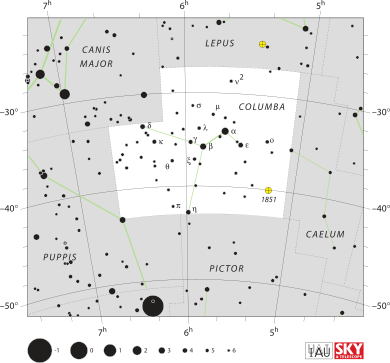Columba (constellation) facts for kids
| Constellation | |

List of stars in Columba
|
|
| Abbreviation | Col |
|---|---|
| Genitive | Columbae |
| Pronunciation | genitive |
| Symbolism | the dove |
| Right ascension | 05h 03m 53.8665s–06h 39m 36.9263s |
| Declination | -27.0772038°–-43.1116486° |
| Area | 270 sq. deg. (54th) |
| Main stars | 5 |
| Bayer/Flamsteed stars |
18 |
| Stars with planets | 1 |
| Stars brighter than 3.00m | 1 |
| Stars within 10.00 pc (32.62 ly) | 0 |
| Brightest star | α Col (Phact) (2.65m) |
| Messier objects | 0 |
| Meteor showers | None |
| Bordering constellations |
Lepus Caelum Pictor Puppis Canis Major |
| Visible at latitudes between +45° and −90°. Best visible at 21:00 (9 p.m.) during the month of February. |
|
Columba is a small, faint constellation created in the late sixteenth century. Its name is Latin for dove. It is located just south of Canis Major and Lepus.
History
Columba was created by Dutch astronomer Petrus Plancius in 1592 in order to differentiate the 'unformed stars' of the large constellation Canis Major.
Plancius originally named the constellation Columba Noachi ("Noah's Dove"), referring to the dove that gave Noah the information that the Great Flood was receding. This name is found on early 17th-century celestial globes and star atlases. Columba may also represent the dove released by Jason and the Argonauts at the Black Sea's mouth; it helped them navigate the dangerous Symplegades.
See also
 In Spanish: Columba (constelación) para niños
In Spanish: Columba (constelación) para niños

All content from Kiddle encyclopedia articles (including the article images and facts) can be freely used under Attribution-ShareAlike license, unless stated otherwise. Cite this article:
Columba (constellation) Facts for Kids. Kiddle Encyclopedia.


